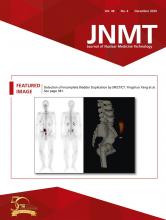Lymphoscintigraphy helps identify the first lymph node (sentinel node) receiving lymphatic drainage from a tumor site and can provide the surgeon with a map to follow during surgery and help stage the disease (1,2).
CLINICAL INDICATIONS
Identification of the sentinel lymph node for surgical excision to stage the disease.
Assistance in planning the incision for sentinel node biopsy.
Evaluation of intermediate-stage primary melanoma.
CONTRAINDICATIONS
Patients who are pregnant or breastfeeding. Pregnancy must be excluded in accordance with local institutional policy. If the patient is breastfeeding, appropriate radiation safety instructions should be provided.
Patients with known metastases.
Patients who have recently undergone a radiopharmaceutical-dependent nuclear medicine study.
PATIENT PREPARATION AND EDUCATION
Fasting requirements for same-day surgical procedures should be followed as prescribed by the surgical department.
A topical numbing agent may be used (lidocaine and prilocaine cream [Emla; AstraZeneca] or cold spray) to minimize pain.
A focused clinical history should be obtained, including previous biopsy results, the pathologic classification of the tumor (thickness and penetration), and surgical excision, if any, of the primary lesion.
ACQUISITION INSTRUCTIONS
Breast
The total dose is divided into 1–4 aliquots (institution-specific). Adding pH-balanced 1% lidocaine to the radiopharmaceutical may improve patient comfort without compromising sentinel lymph node identification.
The injections, performed by the physician or a trained individual, are placed around the tumor or biopsy site approximately 1 cm from the edge of the lesion and may be subdermal, periareolar, subareolar, or intradermal. Ultrasound guidance may be needed to determine the injection location for nonpalpable lesions.
Imaging is tracer-dependent and is performed in 2 phases (Tables 1 and 2). Early-phase static or dynamic imaging to identify the first draining node begins immediately after injection of 99mTc-sulfur colloid or 15 min after injection of 99mTc-tilmanocept for 15–30 min. Delayed-phase imaging to identify lymph node retention and to visualize the sentinel nodes is performed for 30 min to 3 h, at the conclusion of the initial early-phase imaging sequence for either isotope, in the anterior, oblique, and lateral views.
Transmission imaging to delineate the patient’s body contour using a 57Co sheet source may be helpful for localization. Alternatively, a 99mTc point source may be used to trace the body contour outline.
The anterior and lateral locations of the sentinel nodes are marked and labeled on the patient’s skin.
Imaging may not be necessary and is institution-specific (see the “Adjunct Imaging and Interventions” section).
Melanoma
The total dose is divided into 4–8 aliquots with a volume of 0.1 mL each. Each aliquot should contain at least 3,700 kBq (100 μCi) of activity.
The intradermal injections, performed by the physician or a trained individual, are placed around the tumor or biopsy site approximately 1 cm from the edge of the lesion.
Imaging is performed immediately after injection of sulfur colloid or 15 min after injection of 99mTc-tilmanocept, with the patient supine or prone and with the field of view centered over the region of interest.
If the injection is on the trunk, all nodal basins are imaged to rule in or rule out lymphatic involvement. If the injection is on a limb, only nodal basins on that limb and the trunk are imaged (e.g., if injecting an ankle, image the popliteal and inguinal nodes).
A continuous dynamic acquisition (30 s/frame for 30–60 min) or sequential static images (every 5 min for 1 h) are obtained until the sentinel lymph node is identified.
The location of the sentinel node or nodes is marked on the skin.
COMMON OPTIONS
Gentle massage at the injection site may be performed to promote tracer uptake (3).
The area of injection may need to be covered with a piece of lead to better evaluate the lymphatic drainage.
Radioactive markers positioned on known anatomic locations may be helpful.
Oblique and lateral images of the region of interest may be helpful for localization.
For melanoma, imaging of trunk lesions may include axillary and inguinal views; imaging of head and neck lesions may include anterior, posterior, and oblique views, and SPECT/CT may be deemed necessary.
ADJUNCT IMAGING AND INTERVENTIONS
The use of a γ probe in the operating room may replace imaging in some institutions and can help to identify and pinpoint the region with the highest count rate for incision. Important note: The probe should be directed away from the activity at the injection site.
PROCESSING
To enhance low-count areas of the image, contrast enhancement should be used or the upper threshold of the computer display should be lowered.
PRECAUTIONS
Leakage from the injection site may occur. Cover the injection site with gauze.
If an intraoperative γ-probe is used to help locate the sentinel node, the tracer must be injected 15 min to 3 h before surgery. If surgery is delayed by 6 or more hours, obtaining another image before surgery to define further migration of the tracer to additional nodes is advised.
Mapping should not be delayed more than 15 h.







